Optimizing Agri-PV System: Systematic Methodology to Assess Key Design Parameters
Abstract
1. Introduction
1.1. Background and Context
1.2. Relation of Agri-PV to Sustainable Development Goals
1.3. The Current State of the Art and Gap in the Research
1.4. Novelty of the Study
1.5. Research Question
2. Materials and Methods
2.1. Systematic Data Acquisition
2.2. Expert Weighting via Dual AHP
2.3. Weighted Influence Matrices
3. Key Design Indicators
3.1. Land Equivalent Ratio
3.2. Photovoltaic Coverage Ratio
3.3. Shading Factor
3.4. Panel Height
3.5. Tilt Angle
3.6. Photosynthetically Active Radiation (PAR) Utilization
3.7. Crop Yield Stability Index
3.8. Water Use Efficiency
3.9. Economic Feasibility
4. Influencing Matrix and Correlation Analysis
4.1. Expert Consistency and Weight Extraction
4.2. Objective-Specific Weighted Influence Matrices
4.2.1. Factors Influencing Energy Output in Agri-PV
4.2.2. Factors Influencing Crop Productivity in Agri-PV
4.3. Total Weighted Influence Rankings
5. Systematic Evidence Synthesis
5.1. Evidence-Mapping Matrix
5.2. Synthesis of Patterns
5.3. Comparing to Influencing Matrix
6. Limitations and Scope of Future Work
7. Conclusions
Author Contributions
Funding
Data Availability Statement
Conflicts of Interest
References
- Cinderby, S.; Parkhill, K.A.; Langford, S.; Muhoza, C. Harnessing the sun for agriculture: Pathways to the successful expansion of Agrivoltaic systems in East Africa. Energy Res. Soc. Sci. 2024, 116, 103657. [Google Scholar] [CrossRef]
- Fraunhofer Institute for Solar Energy Systems ISE. Agrivoltaics: Opportunities for Agriculture and the Energy Transition: A Guideline for Germany. Available online: https://www.ise.fraunhofer.de/en/publications/studies/agrivoltaics-opportunities-for-agriculture-and-the-energy-transition.html (accessed on 3 March 2025).
- Tajima, M.; Iida, T. Evolution of agrivoltaic farms in Japan. In Proceedings of the Agrivoltaics2020 Conference: Launching Agrivoltaics World-Wide, Perpignan, France, Online, 14–16 October 2020; AIP Publishing: Melville, NY, USA, 2021; p. 30002. [Google Scholar]
- Abidin, M.A.Z.; Mahyuddin, M.N.; Zainuri, M.A.A.M. Agrivoltaic Systems: An Innovative Approach to Combine Agricultural Production and Solar Photovoltaic System. In Proceedings of the 11th International Conference on Robotics, Vision, Signal Processing and Power Applications; Mahyuddin, N.M., Mat Noor, N.R., Mat Sakim, H.A., Eds.; Springer: Singapore, 2022; pp. 779–785. ISBN 978-981-16-8128-8. [Google Scholar]
- Torma, G.; Aschemann-Witzel, J. Social acceptance of dual land use approaches: Stakeholders’ perceptions of the drivers and barriers confronting agrivoltaics diffusion. J. Rural. Stud. 2023, 97, 610–625. [Google Scholar] [CrossRef]
- Choi, C.S.; Ravi, S.; Siregar, I.Z.; Dwiyanti, F.G.; Macknick, J.; Elchinger, M.; Davatzes, N.C. Combined land use of solar infrastructure and agriculture for socioeconomic and environmental co-benefits in the tropics. Renew. Sustain. Energy Rev. 2021, 151, 111610. [Google Scholar] [CrossRef]
- Pandey, G.; Lyden, S.; Franklin, E.; Harrison, M.T. Agrivoltaics as an SDG enabler: Trade-offs and co-benefits for food security, energy generation and emissions mitigation. Resour. Environ. Sustain. 2025, 19, 100186. [Google Scholar] [CrossRef]
- Cuppari, R.I.; Branscomb, A.; Graham, M.; Negash, F.; Smith, A.K.; Proctor, K.; Rupp, D.; Tilahun Ayalew, A.; Getaneh Tilaye, G.; Higgins, C.W.; et al. Agrivoltaics: Synergies and trade-offs in achieving the sustainable development goals at the global and local scale. Appl. Energy 2024, 362, 122970. [Google Scholar] [CrossRef]
- Ghosh, A. Nexus between agriculture and photovoltaics (agrivoltaics, agriphotovoltaics) for sustainable development goal: A review. Sol. Energy 2023, 266, 112146. [Google Scholar] [CrossRef]
- Pandey, D.K.; Mishra, R. Towards sustainable agriculture: Harnessing AI for global food security. Artif. Intell. Agric. 2024, 12, 72–84. [Google Scholar] [CrossRef]
- Datta, P.; Behera, B.; Timsina, J.; Rahut, D.B. Achieving sustainable development through agriculture-forestry-livestock nexus in Bangladesh: Synergies and trade-offs. Agric. Syst. 2024, 215, 103854. [Google Scholar] [CrossRef]
- La Notte, L.; Giordano, L.; Calabrò, E.; Bedini, R.; Colla, G.; Puglisi, G.; Reale, A. Hybrid and organic photovoltaics for greenhouse applications. Appl. Energy 2020, 278, 115582. [Google Scholar] [CrossRef]
- Willockx, B.; Herteleer, B.; Cappelle, J. Combining photovoltaic modules and food crops: First agrovoltaic prototype in Belgium. REPQJ 2020, 18, 266–271. [Google Scholar] [CrossRef]
- Weselek, A.; Ehmann, A.; Zikeli, S.; Lewandowski, I.; Schindele, S.; Högy, P. Agrophotovoltaic systems: Applications, challenges, and opportunities. A review. Agron. Sustain. Dev. 2019, 39, 35. [Google Scholar] [CrossRef]
- Sekiyama, T.; Nagashima, A. Solar Sharing for Both Food and Clean Energy Production: Performance of Agrivoltaic Systems for Corn, A Typical Shade-Intolerant Crop. Environments 2019, 6, 65. [Google Scholar] [CrossRef]
- Soto-Gómez, D. Integration of Crops, Livestock, and Solar Panels: A Review of Agrivoltaic Systems. Agronomy 2024, 14, 1824. [Google Scholar] [CrossRef]
- de Ruijter, F.; Elissen, H.; van Aken, B.; Cesar, K.; Eerenstein, W. Call for a Clear Definition of Agrivoltaics. 2024. Available online: https://edepot.wur.nl/676999 (accessed on 5 April 2025).
- Asa’a, S.; Reher, T.; Rongé, J.; Diels, J.; Poortmans, J.; Radhakrishnan, H.S.; van der Heide, A.; van de Poel, B.; Daenen, M. A multidisciplinary view on agrivoltaics: Future of energy and agriculture. Renew. Sustain. Energy Rev. 2024, 200, 114515. [Google Scholar] [CrossRef]
- Mehta, K.; Shah, M.J.; Zörner, W. Agri-PV (Agrivoltaics) in Developing Countries: Advancing Sustainable Farming to Address the Water–Energy–Food Nexus. Energies 2024, 17, 4440. [Google Scholar] [CrossRef]
- Gomez-Casanovas, N.; Mwebaze, P.; Khanna, M.; Branham, B.; Time, A.; DeLucia, E.H.; Bernacchi, C.J.; Knapp, A.K.; Hoque, M.J.; Du, X.; et al. Knowns, uncertainties, and challenges in agrivoltaics to sustainably intensify energy and food production. Cell Rep. Phys. Sci. 2023, 4, 101518. [Google Scholar] [CrossRef]
- Randle-Boggis, R.J.; Lara, E.; Onyango, J.; Temu, E.J.; Hartley, S.E. Agrivoltaics in East Africa: Opportunities and challenges. In Proceedings of the 6th International Symposium on Current Progress in Mathematics and Sciences 2020 (ISCPMS 2020), Depok, Indonesia, 27–28 October 2020; AIP Publishing: Melville, NY, USA, 2021; p. 90001. [Google Scholar]
- Wild, K.; Schueller, J. Challenges in the Planning, Construction and Farming Practices in Agrivoltaic Systems With Vertically Mounted Panels. AgriVoltaics Conf. Proc. 2024, 2. [Google Scholar] [CrossRef]
- Maier, R.; Lütz, L.; Risch, S.; Kullmann, F.; Weinand, J.; Stolten, D. Potential of floating, parking, and agri photovoltaics in Germany. Renew. Sustain. Energy Rev. 2024, 200, 114500. [Google Scholar] [CrossRef]
- Ferreira, R.F.; Marques Lameirinhas, R.A.; Correia, V.P.; Bernardo, C.; Torres, J.P.N.; Santos, M. Agri-PV in Portugal: How to combine agriculture and photovoltaic production. Energy Sustain. Dev. 2024, 79, 101408. [Google Scholar] [CrossRef]
- Agyekum, E.B. A comprehensive review of two decades of research on agrivoltaics, a promising new method for electricity and food production. Sustain. Energy Technol. Assess. 2024, 72, 104055. [Google Scholar] [CrossRef]
- Chopdar, R.K.; Sengar, N.; Giri, N.C.; Halliday, D. Comprehensive review on agrivoltaics with technical, environmental and societal insights. Renew. Sustain. Energy Rev. 2024, 197, 114416. [Google Scholar] [CrossRef]
- Arena, R.; Aneli, S.; Gagliano, A.; Tina, G.M. Optimal Photovoltaic Array Layout of Agrivoltaic Systems Based on Vertical Bifacial Photovoltaic Modules. Sol. RRL 2024, 8, 2300505. [Google Scholar] [CrossRef]
- Zainali, S.; Ma Lu, S.; Stridh, B.; Avelin, A.; Amaducci, S.; Colauzzi, M.; Campana, P.E. Direct and diffuse shading factors modelling for the most representative agrivoltaic system layouts. Appl. Energy 2023, 339, 120981. [Google Scholar] [CrossRef]
- Elkadeem, M.R.; Zainali, S.; Lu, S.M.; Younes, A.; Abido, M.A.; Amaducci, S.; Croci, M.; Zhang, J.; Landelius, T.; Stridh, B.; et al. Agrivoltaic systems potentials in Sweden: A geospatial-assisted multi-criteria analysis. Appl. Energy 2024, 356, 122108. [Google Scholar] [CrossRef]
- Chowdhury, R.; Shufian, A.; Nusrat, S.; Mohammad, N. Design and Simulation of Standalone Solar Agri-PV System in Bangladesh: A Case Study. In Proceedings of the 2023 IEEE 11th Region 10 Humanitarian Technology Conference (R10-HTC), Rajkot, India, 16–18 October 2023; IEEE: Piscataway, NJ, USA, 2023; pp. 946–951, ISBN 979-8-3503-2614-7. [Google Scholar]
- Willockx, B.; Uytterhaegen, B.; Ronsijn, B.; Herteleer, B.; Cappelle, J. A Standardized Classification and Performance Indicators of Agrivoltaic Systems. In Proceedings of the 37th European Photovoltaic Solar Energy Conference and Exhibition, Online, 7–11 September 2020; pp. 1995–1998. [Google Scholar] [CrossRef]
- Barron-Gafford, G.A.; Pavao-Zuckerman, M.A.; Minor, R.L.; Sutter, L.F.; Barnett-Moreno, I.; Blackett, D.T.; Thompson, M.; Dimond, K.; Gerlak, A.K.; Nabhan, G.P.; et al. Agrivoltaics provide mutual benefits across the food–energy–water nexus in drylands. Nat. Sustain. 2019, 2, 848–855. [Google Scholar] [CrossRef]
- Weselek, A.; Bauerle, A.; Hartung, J.; Zikeli, S.; Lewandowski, I.; Högy, P. Agrivoltaic system impacts on microclimate and yield of different crops within an organic crop rotation in a temperate climate. Agron. Sustain. Dev. 2021, 41, 59. [Google Scholar] [CrossRef]
- Elamri, Y.; Cheviron, B.; Lopez, J.-M.; Dejean, C.; Belaud, G. Water budget and crop modelling for agrivoltaic systems: Application to irrigated lettuces. Agric. Water Manag. 2018, 208, 440–453. [Google Scholar] [CrossRef]
- Fattoruso, G.; Toscano, D.; Venturo, A.; Scognamiglio, A.; Fabricino, M.; Di Francia, G. A Spatial Multicriteria Analysis for a Regional Assessment of Eligible Areas for Sustainable Agrivoltaic Systems in Italy. Sustainability 2024, 16, 911. [Google Scholar] [CrossRef]
- Wagner, J.; Bühner, C.; Gölz, S.; Trommsdorff, M.; Jürkenbeck, K. Factors influencing the willingness to use agrivoltaics: A quantitative study among German farmers. Appl. Energy 2024, 361, 122934. [Google Scholar] [CrossRef]
- Patel, U.R.; Gadhiya, G.A.; Chauhan, P.M. Techno-economic analysis of agrivoltaic system for affordable and clean energy with food production in India. Clean Technol. Environ. Policy 2024, 26, 2117–2135. [Google Scholar] [CrossRef]
- Zahrawi, A.A.; Aly, A.M. A Review of Agrivoltaic Systems: Addressing Challenges and Enhancing Sustainability. Sustainability 2024, 16, 8271. [Google Scholar] [CrossRef]
- Bellone, Y.; Croci, M.; Impollonia, G.; Nik Zad, A.; Colauzzi, M.; Campana, P.E.; Amaducci, S. Simulation-Based Decision Support for Agrivoltaic Systems. Appl. Energy 2024, 369, 123490. [Google Scholar] [CrossRef]
- Toledo, C.; Scognamiglio, A. Agrivoltaic Systems Design and Assessment: A Critical Review, and a Descriptive Model towards a Sustainable Landscape Vision (Three-Dimensional Agrivoltaic Patterns). Sustainability 2021, 13, 6871. [Google Scholar] [CrossRef]
- Dupraz, C.; Marrou, H.; Talbot, G.; Dufour, L.; Nogier, A.; Ferard, Y. Combining solar photovoltaic panels and food crops for optimising land use: Towards new agrivoltaic schemes. Renew. Energy 2011, 36, 2725–2732. [Google Scholar] [CrossRef]
- Zheng, J.; Meng, S.; Zhang, X.; Zhao, H.; Ning, X.; Chen, F.; Abaker Omer, A.A.; Ingenhoff, J.; Liu, W. Increasing the comprehensive economic benefits of farmland with Even-lighting Agrivoltaic Systems. PLoS ONE 2021, 16, e0254482. [Google Scholar] [CrossRef] [PubMed]
- Giri, N.C.; Mohanty, R.C. Agrivoltaic system: Experimental analysis for enhancing land productivity and revenue of farmers. Energy Sustain. Dev. 2022, 70, 54–61. [Google Scholar] [CrossRef]
- Campana, P.E.; Stridh, B.; Hörndahl, T.; Svensson, S.-E.; Zainali, S.; Lu, S.M.; Zidane, T.E.K.; de Luca, P.; Amaducci, S.; Colauzzi, M. Experimental results, integrated model validation, and economic aspects of agrivoltaic systems at northern latitudes. J. Clean. Prod. 2024, 437, 140235. [Google Scholar] [CrossRef]
- Dupraz, C. Assessment of the ground coverage ratio of agrivoltaic systems as a proxy for potential crop productivity. Agroforest Syst. 2024, 98, 2679–2696. [Google Scholar] [CrossRef]
- Aroca-Delgado, R.; Pérez-Alonso, J.; Callejón-Ferre, Á.; Velázquez-Martí, B. Compatibility between Crops and Solar Panels: An Overview from Shading Systems. Sustainability 2018, 10, 743. [Google Scholar] [CrossRef]
- Aroca-Delgado, R.; Pérez-Alonso, J.; Callejón-Ferre, Á.-J.; Díaz-Pérez, M. Morphology, yield and quality of greenhouse tomato cultivation with flexible photovoltaic rooftop panels (Almería-Spain). Sci. Hortic. 2019, 257, 108768. [Google Scholar] [CrossRef]
- Ramezani, F.; Mirhosseini, M. Shading impact modeling on photovoltaic panel performance. Renew. Sustain. Energy Rev. 2025, 212, 115432. [Google Scholar] [CrossRef]
- Touil, S.; Richa, A.; Fizir, M.; Bingwa, B. Shading effect of photovoltaic panels on horticulture crops production: A mini review. Rev. Environ. Sci. Biotechnol. 2021, 20, 281–296. [Google Scholar] [CrossRef]
- Cheng, B.; Wang, L.; Liu, R.; Wang, W.; Yu, R.; Zhou, T.; Ahmad, I.; Raza, A.; Jiang, S.; Xu, M.; et al. Shade-Tolerant Soybean Reduces Yield Loss by Regulating Its Canopy Structure and Stem Characteristics in the Maize-Soybean Strip Intercropping System. Front. Plant Sci. 2022, 13, 848893. [Google Scholar] [CrossRef] [PubMed]
- Kallioğlu, M.A.; Avcı, A.S.; Sharma, A.; Khargotra, R.; Singh, T. Solar collector tilt angle optimization for agrivoltaic systems. Case Stud. Therm. Eng. 2024, 54, 103998. [Google Scholar] [CrossRef]
- Nathalie, C.; Munier-Jolain, N.; Dugué, F.; Gardarin, A.; Strbik, F.; Moreau, D. The response of weed and crop species to shading. How to predict their morphology and plasticity from species traits and ecological indexes? Eur. J. Agron. 2020, 121, 126158. [Google Scholar] [CrossRef]
- Silva, M.; Roberts, J.J.; Prado, P.O. Calculation of the Shading Factors for Solar Modules with MATLAB. Energies 2021, 14, 4713. [Google Scholar] [CrossRef]
- Almadhhachi, M.; Seres, I.; Farkas, I. Sunflower solar tree vs. flat PV module: A comprehensive analysis of performance, efficiency, and land savings in urban solar integration. Results Eng. 2024, 21, 101742. [Google Scholar] [CrossRef]
- Ali Khan Niazi, K.; Victoria, M. Comparative analysis of photovoltaic configurations for agrivoltaic systems in Europe. Prog. Photovolt. 2023, 31, 1101–1113. [Google Scholar] [CrossRef]
- Laub, M.; Pataczek, L.; Feuerbacher, A.; Zikeli, S.; Högy, P. Contrasting yield responses at varying levels of shade suggest different suitability of crops for dual land-use systems: A meta-analysis. Agron. Sustain. Dev. 2022, 42, 51. [Google Scholar] [CrossRef]
- Sarr, A.; Soro, Y.M.; Tossa, A.K.; Diop, L. A new approach for modelling photovoltaic panel configuration maximizing crop yield and photovoltaic array outputs in agrivoltaics systems. Energy Convers. Manag. 2024, 309, 118436. [Google Scholar] [CrossRef]
- Ramos-Fuentes, I.A.; Elamri, Y.; Cheviron, B.; Dejean, C.; Belaud, G.; Fumey, D. Effects of shade and deficit irrigation on maize growth and development in fixed and dynamic AgriVoltaic systems. Agric. Water Manag. 2023, 280, 108187. [Google Scholar] [CrossRef]
- Li, T.; Yang, Q. Advantages of diffuse light for horticultural production and perspectives for further research. Front. Plant Sci. 2015, 6, 704. [Google Scholar] [CrossRef] [PubMed]
- Smith, S.E.; Viggiano, B.; Ali, N.; Silverman, T.J.; Obligado, M.; Calaf, M.; Cal, R.B. Increased panel height enhances cooling for photovoltaic solar farms. Appl. Energy 2022, 325, 119819. [Google Scholar] [CrossRef]
- Williams, H.J.; Hashad, K.; Wang, H.; Max Zhang, K. The potential for agrivoltaics to enhance solar farm cooling. Appl. Energy 2023, 332, 120478. [Google Scholar] [CrossRef]
- Chalgynbayeva, A.; Gabnai, Z.; Lengyel, P.; Pestisha, A.; Bai, A. Worldwide Research Trends in Agrivoltaic Systems—A Bibliometric Review. Energies 2023, 16, 611. [Google Scholar] [CrossRef]
- Prakash, V.; Lunagaria, M.M.; Trivedi, A.P.; Upadhyaya, A.; Kumar, R.; Das, A.; Kumar Gupta, A.; Kumar, Y. Shading and PAR under different density agrivoltaic systems, their simulation and effect on wheat productivity. Eur. J. Agron. 2023, 149, 126922. [Google Scholar] [CrossRef]
- Widmer, J.; Christ, B.; Grenz, J.; Norgrove, L. Agrivoltaics, a promising new tool for electricity and food production: A systematic review. Renew. Sustain. Energy Rev. 2024, 192, 114277. [Google Scholar] [CrossRef]
- Ibrahim, Z.; Aljanabi, M. Influence of Tilt Angle on PV Output for Solar Energy Optimization in Iraq. Salud Cienc. Tecnol.-Ser. Conf. 2024, 3, 871. [Google Scholar] [CrossRef]
- Abidin, M.A.Z.; Mahyuddin, M.N.; Zainuri, M.A.A.M. Optimal Efficient Energy Production by PV Module Tilt-Orientation Prediction Without Compromising Crop-Light Demands in Agrivoltaic Systems. IEEE Access 2023, 11, 71557–71572. [Google Scholar] [CrossRef]
- Mõttus, M.; Sulev, M.; Baret, F.; Lopez-Lozano, R.; Reinart, A. Photosynthetically Active Radiation: Measurement and Modeling. In Encyclopedia of Sustainability Science and Technology; Meyers, R.A., Ed.; Springer: New York, NY, USA, 2012; pp. 7902–7932. ISBN 978-0-387-89469-0. [Google Scholar]
- Edouard, S.; Combes, D.; van Iseghem, M.; Ng Wing Tin, M.; Escobar-Gutiérrez, A.J. Increasing land productivity with agriphotovoltaics: Application to an alfalfa field. Appl. Energy 2023, 329, 120207. [Google Scholar] [CrossRef]
- Martinez-Garcia, J.F.; Rodriguez-Concepcion, M. Molecular mechanisms of shade tolerance in plants. New Phytol. 2023, 239, 1190–1202. [Google Scholar] [CrossRef] [PubMed]
- Bacsi, Z.; Hollósy, Z. A yield stability index and its application for crop production. Anal. Tech. Szeged. 2019, 13, 11–20. [Google Scholar] [CrossRef]
- Macholdt, J.; Styczen, M.E.; Macdonald, A.; Piepho, H.-P.; Honermeier, B. Long-term analysis from a cropping system perspective: Yield stability, environmental adaptability, and production risk of winter barley. Eur. J. Agron. 2020, 117, 126056. [Google Scholar] [CrossRef]
- Raseduzzaman, M.; Jensen, E.S. Does intercropping enhance yield stability in arable crop production? A meta-analysis. Eur. J. Agron. 2017, 91, 25–33. [Google Scholar] [CrossRef]
- Amaducci, S.; Yin, X.; Colauzzi, M. Agrivoltaic systems to optimise land use for electric energy production. Appl. Energy 2018, 220, 545–561. [Google Scholar] [CrossRef]
- Mamun, M.A.A.; Dargusch, P.; Wadley, D.; Zulkarnain, N.A.; Aziz, A.A. A review of research on agrivoltaic systems. Renew. Sustain. Energy Rev. 2022, 161, 112351. [Google Scholar] [CrossRef]
- Gasch, A.; Lara, R.; Pearce, J.M. Financial analysis of agrivoltaic sheep: Breeding and auction lamb business models. Appl. Energy 2025, 381, 125057. [Google Scholar] [CrossRef]
- Patel, B.; Gami, B.; Baria, V.; Patel, A.; Patel, P. Co-Generation of Solar Electricity and Agriculture Produce by Photovoltaic and Photosynthesis—Dual Model by Abellon, India. J. Sol. Energy Eng. 2019, 141, 031014. [Google Scholar] [CrossRef]
- Saaty, T.L. Decision making with the analytic hierarchy process. IJSSCI 2008, 1, 83. [Google Scholar] [CrossRef]
- Artru, S.; Garré, S.; Dupraz, C.; Hiel, M.-P.; Blitz-Frayret, C.; Lassois, L. Impact of spatio-temporal shade dynamics on wheat growth and yield, perspectives for temperate agroforestry. Eur. J. Agron. 2017, 82, 60–70. [Google Scholar] [CrossRef]
- Zainali, S.; Lu, S.M.; Fernández-Solas, Á.; Cruz-Escabias, A.; Fernández, E.F.; Zidane, T.E.K.; Honningdalsnes, E.H.; Nygård, M.M.; Leloux, J.; Berwind, M.; et al. Modelling, simulation, and optimisation of agrivoltaic systems: A comprehensive review. Appl. Energy 2025, 386, 125558. [Google Scholar] [CrossRef]
- Williams, H.J.; Wang, Y.; Yuan, B.; Gómez, M.I.; Vanden Heuvel, J.; Zhang, K.M. Bringing solar to agriculture: An interdisciplinary design and analysis of a Concord grape agrivoltaic system. Appl. Energy 2025, 393, 126021. [Google Scholar] [CrossRef]
- Willockx, B.; Reher, T.; Lavaert, C.; Herteleer, B.; van de Poel, B.; Cappelle, J. Design and evaluation of an agrivoltaic system for a pear orchard. Appl. Energy 2024, 353, 122166. [Google Scholar] [CrossRef]
- Sojib Ahmed, M.; Rezwan Khan, M.; Haque, A.; Ryyan Khan, M. Agrivoltaics analysis in a techno-economic framework: Understanding why agrivoltaics on rice will always be profitable. Appl. Energy 2022, 323, 119560. [Google Scholar] [CrossRef]
- Neupane Bhandari, S.; Schlüter, S.; Kuckshinrichs, W.; Schlör, H.; Adamou, R.; Bhandari, R. Economic Feasibility of Agrivoltaic Systems in Food-Energy Nexus Context: Modelling and a Case Study in Niger. Agronomy 2021, 11, 1906. [Google Scholar] [CrossRef]
- Ukwu, U.N.; Muller, O.; Meier-Grüll, M.; Uguru, M.I. Agrivoltaics shading enhanced the microclimate, photosynthesis, growth and yields of vigna radiata genotypes in tropical Nigeria. Sci. Rep. 2025, 15, 1190. [Google Scholar] [CrossRef] [PubMed]
- Giri, N.C.; Mohanty, R.C.; Pradhan, R.C.; Abdullah, S.; Ghosh, U.; Mukherjee, A. Agrivoltaic system for energy-food production: A symbiotic approach on strategy, modelling, and optimization. Sustain. Comput. Inform. Syst. 2023, 40, 100915. [Google Scholar] [CrossRef]
- Trommsdorff, M.; Kang, J.; Reise, C.; Schindele, S.; Bopp, G.; Ehmann, A.; Weselek, A.; Högy, P.; Obergfell, T. Combining food and energy production: Design of an agrivoltaic system applied in arable and vegetable farming in Germany. Renew. Sustain. Energy Rev. 2021, 140, 110694. [Google Scholar] [CrossRef]
- Hussain, S.N.; Ghosh, A. Evaluating tracking bifacial solar PV based agrivoltaics system across the UK. Sol. Energy 2024, 284, 113102. [Google Scholar] [CrossRef]
- Cho, J.; Park, S.M.; Park, A.R.; Lee, O.C.; Nam, G.; Ra, I.-H. Application of Photovoltaic Systems for Agriculture: A Study on the Relationship between Power Generation and Farming for the Improvement of Photovoltaic Applications in Agriculture. Energies 2020, 13, 4815. [Google Scholar] [CrossRef]
- Thompson, E.P.; Bombelli, E.L.; Shubham, S.; Watson, H.; Everard, A.; D’Ardes, V.; Schievano, A.; Bocchi, S.; Zand, N.; Howe, C.J.; et al. Tinted Semi-Transparent Solar Panels Allow Concurrent Production of Crops and Electricity on the Same Cropland. Adv. Energy Mater. 2020, 10, 2001189. [Google Scholar] [CrossRef]
- Magarelli, A.; Mazzeo, A.; Ferrara, G. Fruit Crop Species with Agrivoltaic Systems: A Critical Review. Agronomy 2024, 14, 722. [Google Scholar] [CrossRef]
- Rondán-Sanabria, G.G.; Flores Sacsi, E.S.; Delgado Huamani, E.R.; Velarde Allazo, E.A. Evaluation of radish (Raphanus sativus L.) crop productivity under shading in an agrovoltaic system in two seasons of the year in Arequipa, Perú-2023. In Proceedings of the 2023 International Conference on Electrical, Communication and Computer Engineering (ICECCE), Dubai, United Arab Emirates, 30–31 December 2023; IEEE: Piscataway, NJ, USA, 2023; pp. 1–7, ISBN 979-8-3503-6969-4. [Google Scholar]
- Tan, Y.; Liu, J.; Li, W.; Yin, J.; Chen, H.; Peng, Y.; Tan, J.; Wei, M. Agrivoltaics development progresses: From the perspective of photovoltaic impact on crops, soil ecology and climate. Environ. Res. 2025, 266, 120540. [Google Scholar] [CrossRef] [PubMed]
- Ali Abaker Omer, A.; Li, M.; Zhang, F.; Hassaan, M.M.E.; El Kolaly, W.; Zhang, X.; Lan, H.; Liu, J.; Liu, W. Impacts of agrivoltaic systems on microclimate, water use efficiency, and crop yield: A systematic review. Renew. Sustain. Energy Rev. 2025, 221, 115930. [Google Scholar] [CrossRef]
- Ali Abaker Omer, A.; Liu, W.; Li, M.; Zheng, J.; Zhang, F.; Zhang, X.; Osman Hamid Mohammed, S.; Fan, L.; Liu, Z.; Chen, F.; et al. Water evaporation reduction by the agrivoltaic systems development. Sol. Energy 2022, 247, 13–23. [Google Scholar] [CrossRef]
- Trommsdorff, M.; Vorast, M.; Durga, N.; Padwardhan, S.M. Potential of agrivoltaics to contribute to socio-economic sustainability: A case study in Maharashtra/India. In Proceedings of the Agrivoltaics2020 Conference: Launching Agrivoltaics World-Wide, Perpignan, France, 14–16 October 2020; AIP Publishing: Melville, NY, USA, 2021; p. 40001. [Google Scholar]
- Chen, B.L.; Yang, H.K.; Ma, Y.N.; Liu, J.R.; Lv, F.J.; Chen, J.; Meng, Y.L.; Wang, Y.H.; Zhou, Z.G. Effect of shading on yield, fiber quality and physiological characteristics of cotton subtending leaves on different fruiting positions. Photosynthetica 2017, 55, 240–250. [Google Scholar] [CrossRef]
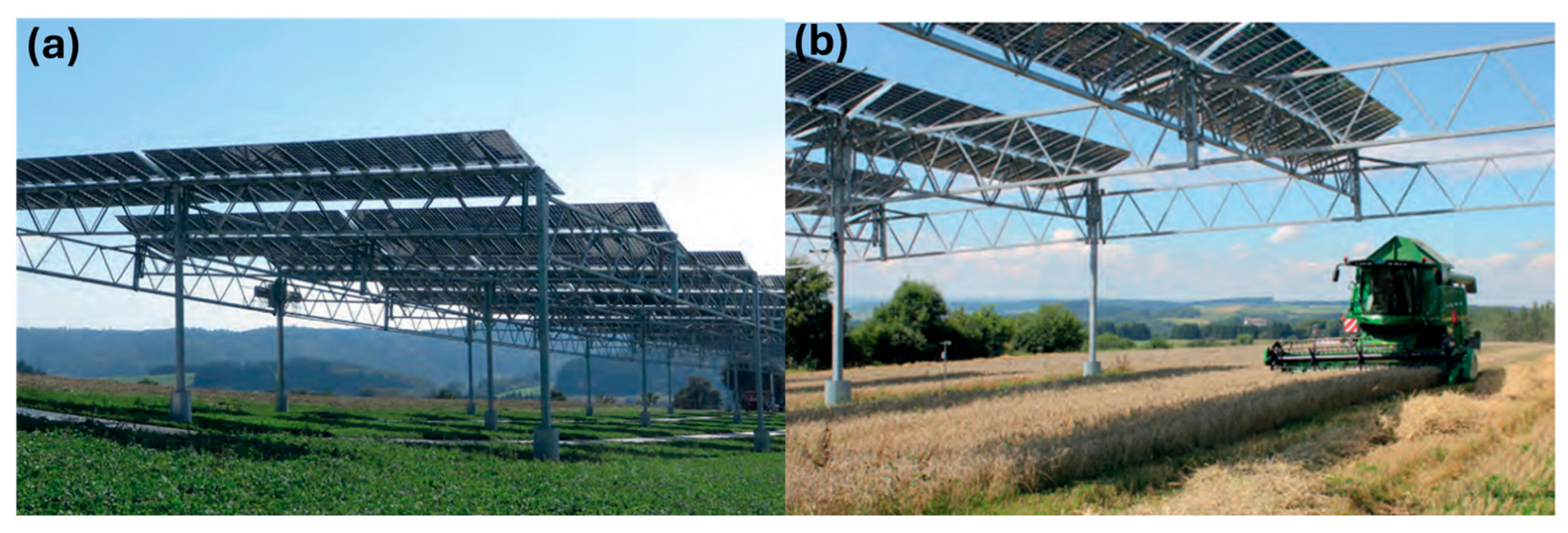
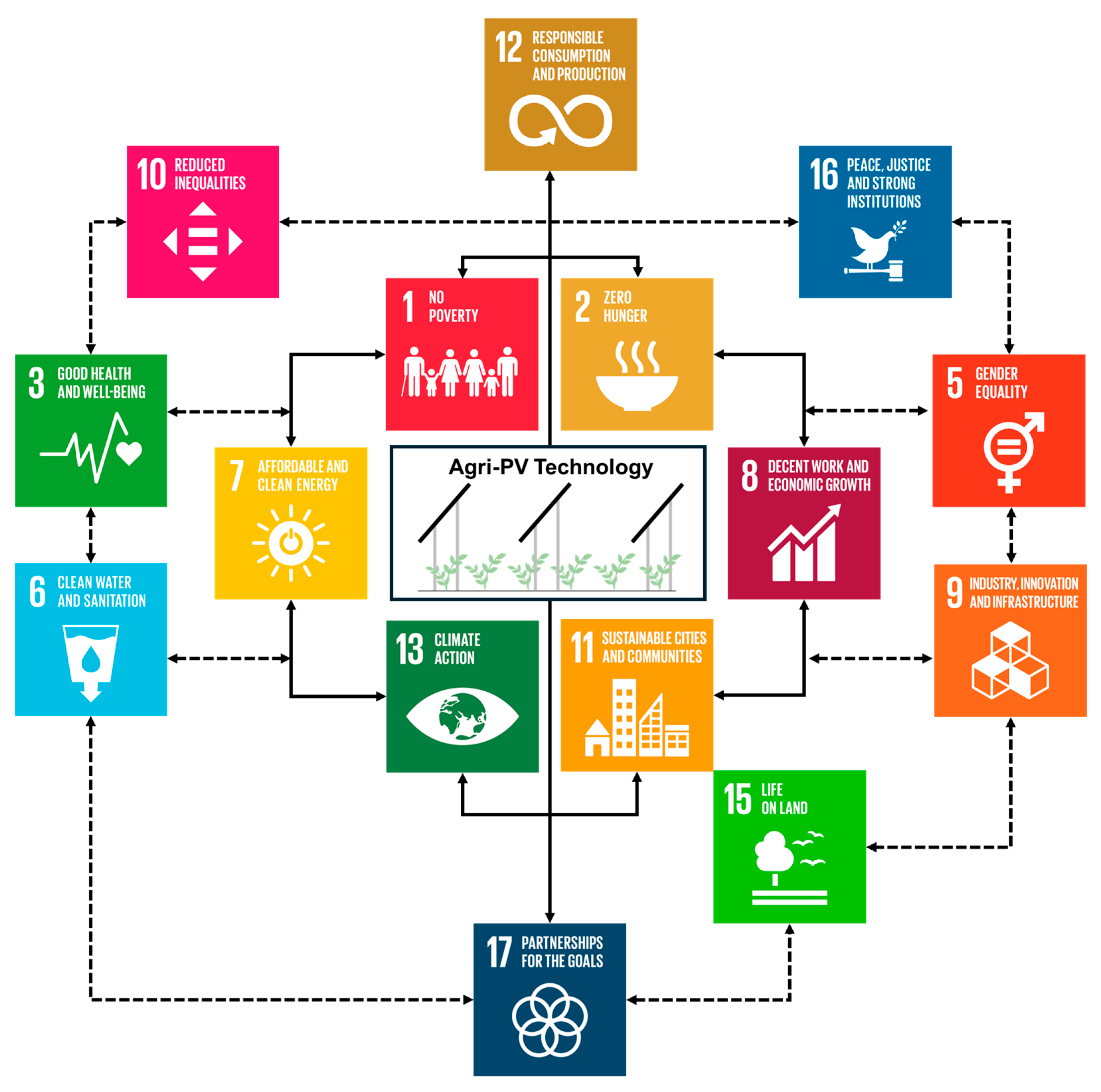
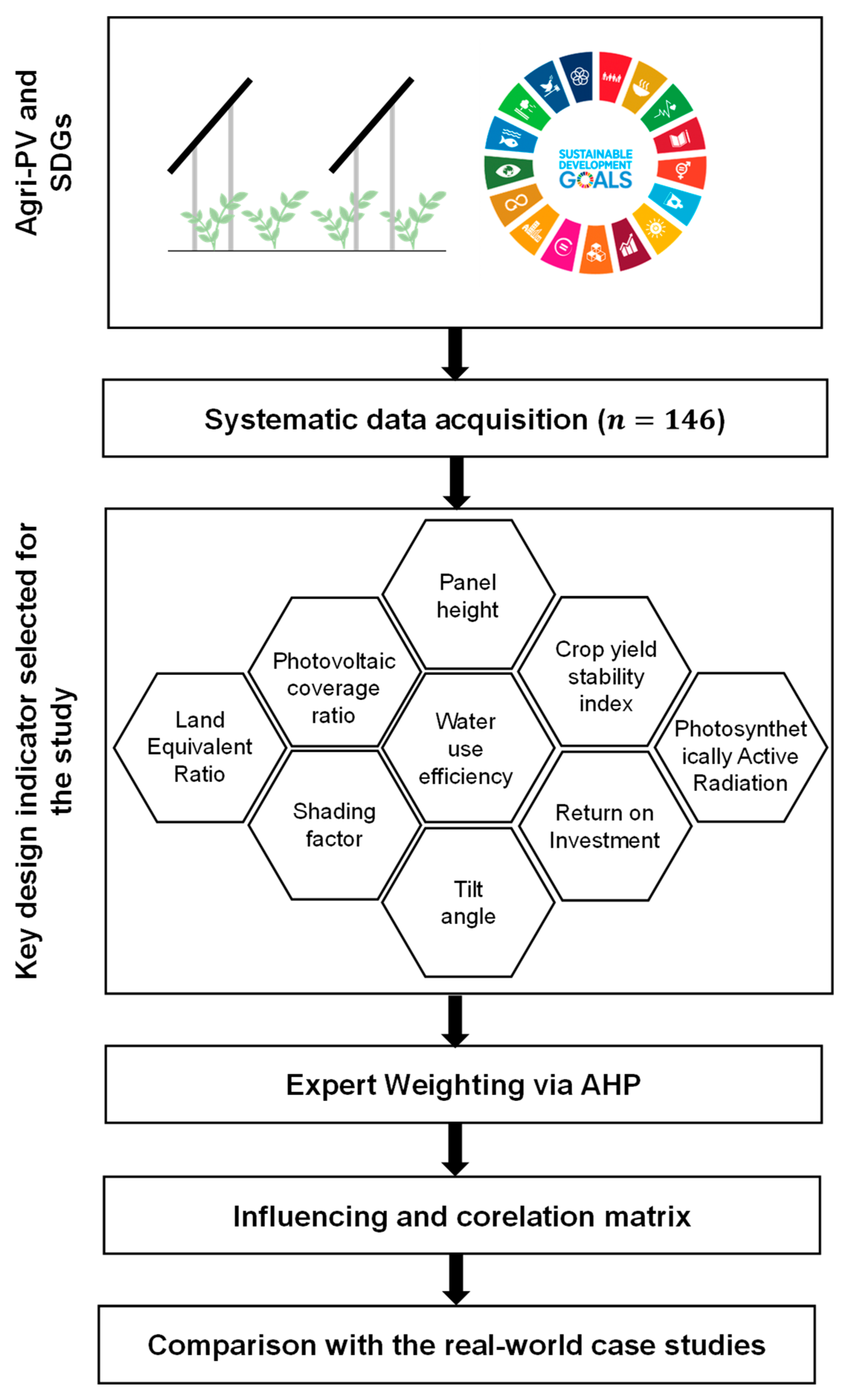
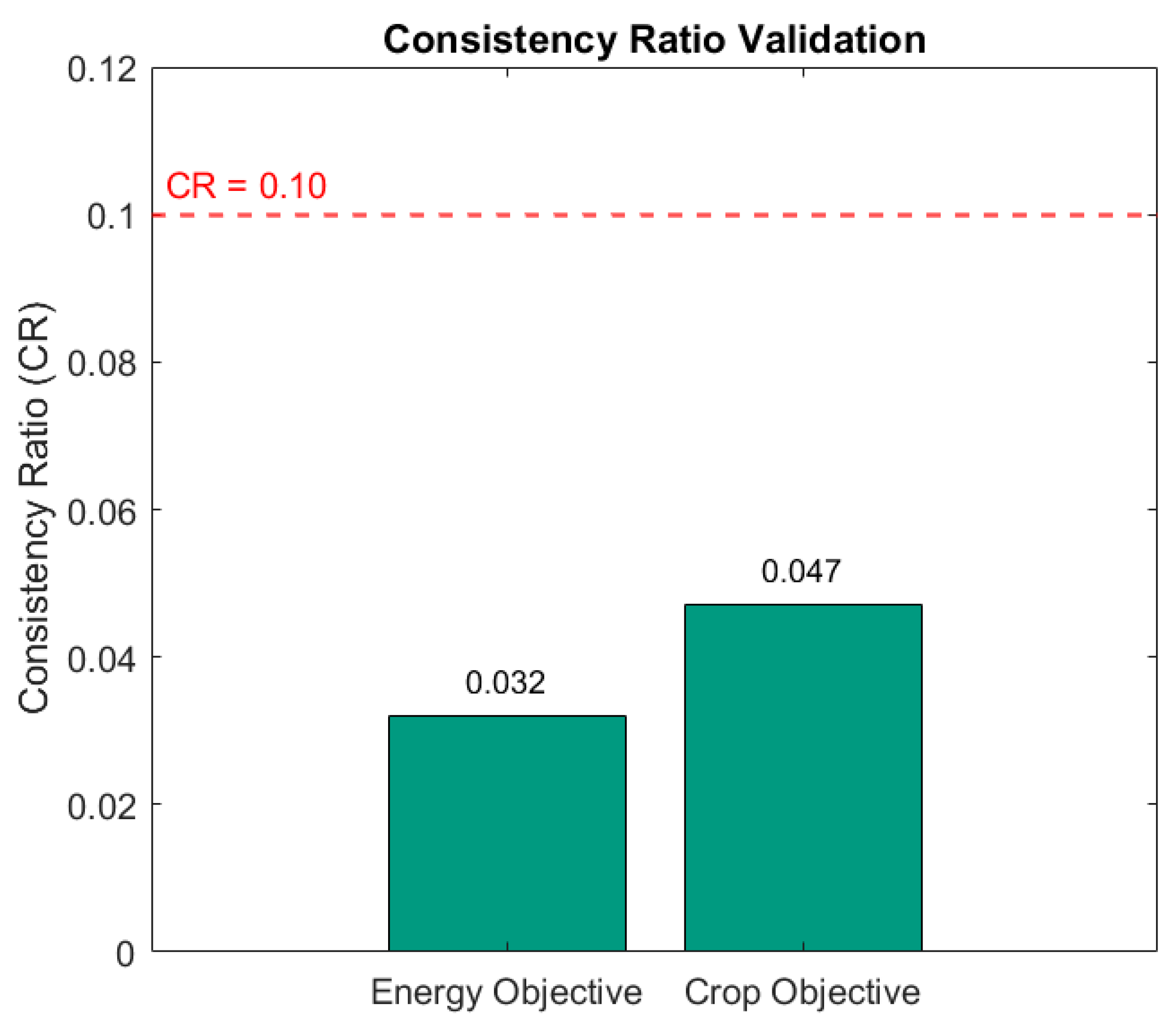
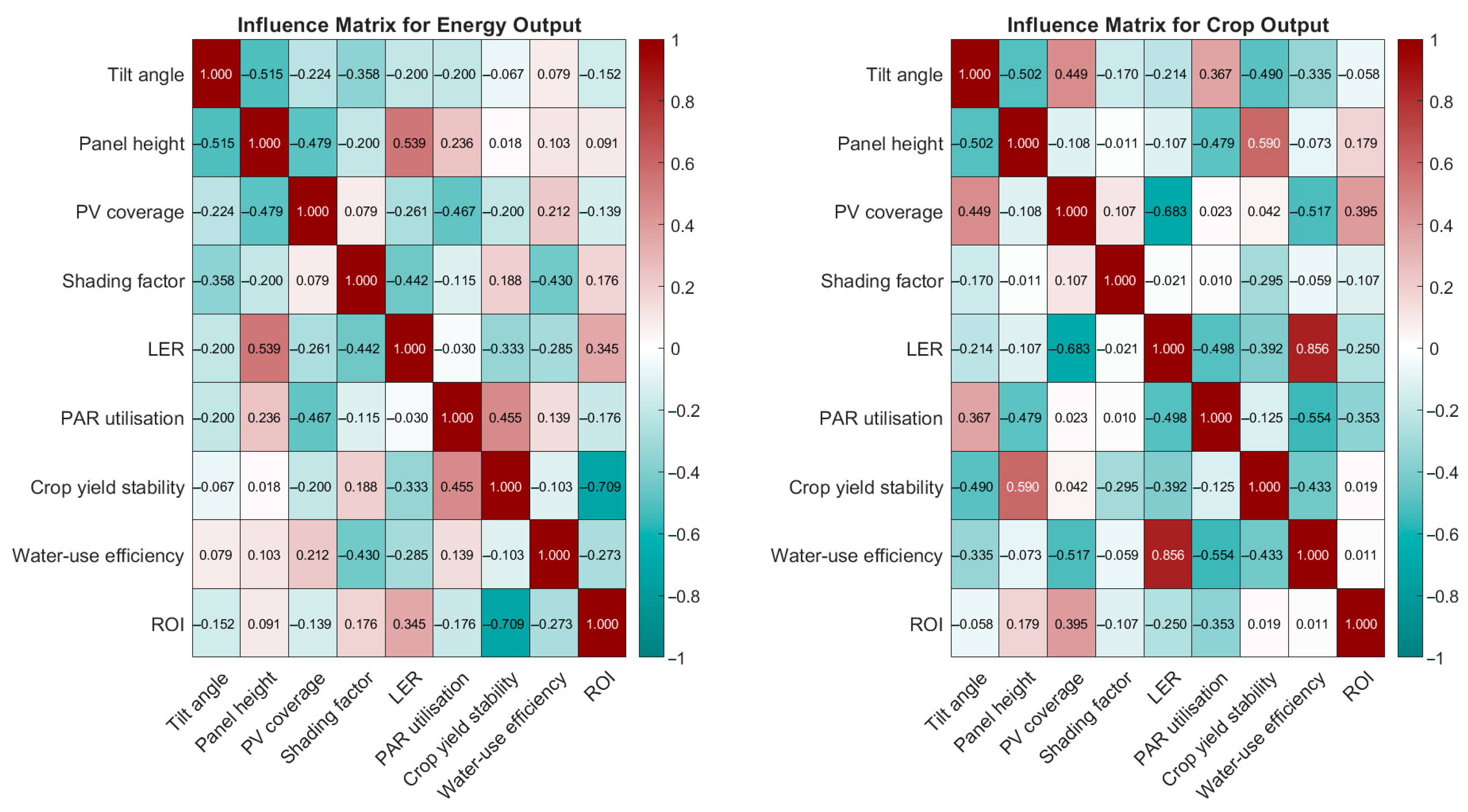
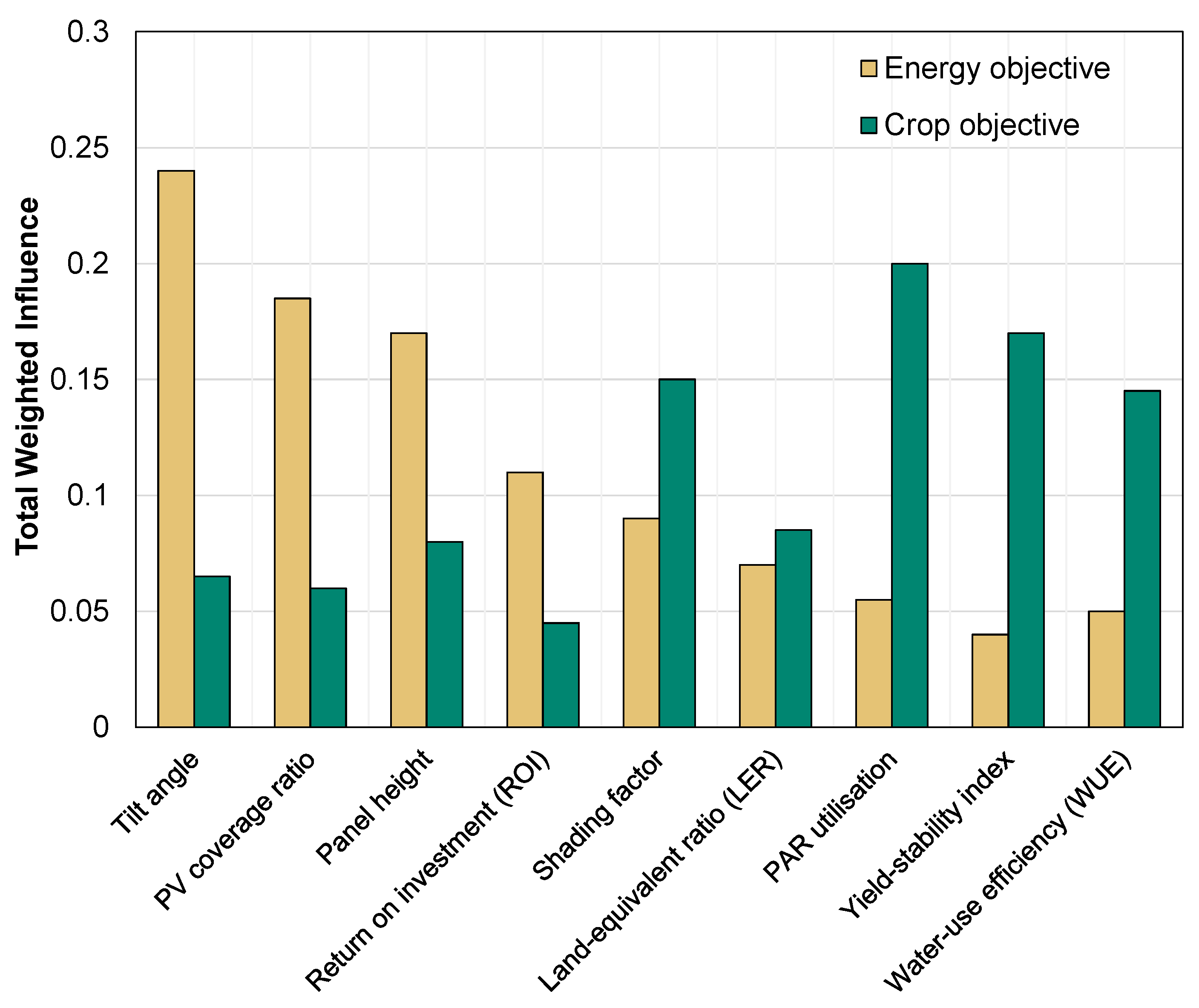
| Source | Method | Focus | Parameters | Dual Objective (Energy + Crop) |
|---|---|---|---|---|
| Barron-Gafford et al. [32] | Field experiment | Tilt & height | ✖ (single-factor) | Partial (qualitative) |
| Weselek et al. [33] | Crop-climate model | Tilt & height | ✖ | ✖ |
| Elamri et al. [34] | Field + LER calc | PCR & SF | ✖ | ✖ |
| Fattoruso et al. [35] | GIS-AHP | Site selection | ✔ (land layers) | ✖ |
| Asa’a et al. [18] | Fuzzy TOPSIS | Site selection | ✔ (land layers) | ✖ |
| Zahrawi and Aly [38] | Review | Challenges | N/A | ✖ |
| This study | Dual-matrix + AHP | Design optimisation | ✔ (9 parameters) | ✔ |
| Design Indicator | Expert Weightage for Energy Generation (w_E) | Rank for Energy Generation | Expert Weightage for Crop Productivity (w_C) | Rank for Crop Productivity | Remark |
|---|---|---|---|---|---|
| Tilt Angle | 0.24 | 1 | 0.065 | 7 | Highest priority for energy, low for crop |
| Photovoltaic Coverage Ratio | 0.185 | 2 | 0.06 | 8 | Second for energy, moderate for crop |
| Panel Height | 0.17 | 3 | 0.08 | 6 | High energy influence, low crop influence |
| Return on Investment | 0.11 | 4 | 0.045 | 9 | Moderate energy, high crop influence |
| Shading Factor | 0.09 | 5 | 0.15 | 3 | Lower energy, moderate crop influence |
| Land Equivalent Ratio | 0.07 | 6 | 0.085 | 5 | Low energy, highest crop priority |
| PAR Utilization | 0.055 | 7 | 0.2 | 1 | Minimal energy, strong crop importance |
| Crop-Yield Stability Index | 0.054 | 8 | 0.17 | 2 | Least energy, moderate crop importance |
| Water-Use Efficiency | 0.051 | 9 | 0.145 | 4 | Economic factor ranks mid/low for both |
| Factor | Energy (↑) | Energy (≈) | Energy (↓) | Crop (↑) | Crop (≈) | Crop (↓) | References |
|---|---|---|---|---|---|---|---|
| Tilt Angle | 18 | 2 | 1 | 2 | 5 | 14 | [41,64] |
| Coverage Ratio (GCR) | 15 | 3 | 3 | 1 | 2 | 18 | [41,48,78,79] |
| Panel Height | 12 | 6 | 3 | 5 | 9 | 7 | [80,81] |
| Return on Investment (ROI) | 6 | 9 | 6 | n/a | n/a | n/a | [82,83] |
| Shading Factor | 14 | 4 | 3 | 2 | 3 | 16 | [63,84] |
| Land Equivalent Ratio (LER) | 10 | 7 | 4 | 8 | 5 | 8 | [85,86,87] |
| PAR Utilisation | 9 | 8 | 4 | 4 | 6 | 11 | [88,89] |
| Yield-Stability Index | 8 | 10 | 3 | 6 | 8 | 7 | [90,91,92] |
| Water-Use Efficiency (WUE) | 7 | 11 | 3 | 7 | 9 | 5 | [93,94] |
| Factor | Evidence-Frequency Rank_E | Weight_E | Evidence-Frequency Rank_C | Weight_C |
|---|---|---|---|---|
| Tilt Angle | 1 | 0.240 | 3 | 0.065 |
| Coverage Ratio | 2 | 0.185 | 1 | 0.060 |
| Shading Factor | 3 | 0.090 | 2 | 0.150 |
| Panel Height | 4 | 0.170 | 4 | 0.080 |
| LER | 5 | 0.070 | 5 | 0.085 |
| PAR Utilisation | 6 | 0.055 | 6 | 0.200 |
| Yield-Stability | 7 | 0.040 | 7 | 0.170 |
| WUE | 8 | 0.050 | 8 | 0.145 |
| ROI | 9 | 0.110 | 9 | 0.045 |
Disclaimer/Publisher’s Note: The statements, opinions and data contained in all publications are solely those of the individual author(s) and contributor(s) and not of MDPI and/or the editor(s). MDPI and/or the editor(s) disclaim responsibility for any injury to people or property resulting from any ideas, methods, instructions or products referred to in the content. |
© 2025 by the authors. Licensee MDPI, Basel, Switzerland. This article is an open access article distributed under the terms and conditions of the Creative Commons Attribution (CC BY) license (https://creativecommons.org/licenses/by/4.0/).
Share and Cite
Mehta, K.; Zörner, W. Optimizing Agri-PV System: Systematic Methodology to Assess Key Design Parameters. Energies 2025, 18, 3877. https://doi.org/10.3390/en18143877
Mehta K, Zörner W. Optimizing Agri-PV System: Systematic Methodology to Assess Key Design Parameters. Energies. 2025; 18(14):3877. https://doi.org/10.3390/en18143877
Chicago/Turabian StyleMehta, Kedar, and Wilfried Zörner. 2025. "Optimizing Agri-PV System: Systematic Methodology to Assess Key Design Parameters" Energies 18, no. 14: 3877. https://doi.org/10.3390/en18143877
APA StyleMehta, K., & Zörner, W. (2025). Optimizing Agri-PV System: Systematic Methodology to Assess Key Design Parameters. Energies, 18(14), 3877. https://doi.org/10.3390/en18143877






